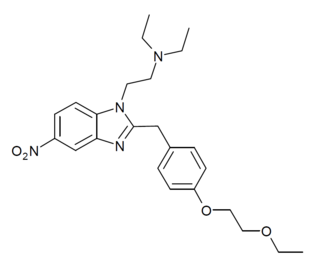
Benzimidazole is a heterocyclic aromatic organic compound. This bicyclic compound may be viewed as fused rings of the aromatic compounds benzene and imidazole. It is a white solid that appears in form of tabular crystals.

Etonitazene, also known as EA-4941 or CS-4640, is a benzimidazole opioid, first reported in 1957, that has been shown to have approximately 1,000 to 1,500 times the potency of morphine in animals.

Lofentanil or lofentanyl is one of the most potent opioid analgesics known and is an analogue of fentanyl, which was developed in 1960. It is most similar to the highly potent opioid carfentanil (4-carbomethoxyfentanyl), only slightly more potent. Lofentanil can be described as 3-methylcarfentanil, or 3-methyl-4-carbomethoxyfentanyl. While 3-methylfentanyl is considerably more potent than fentanyl itself, lofentanil is only slightly stronger than carfentanil. This suggests that substitution at both the 3 and 4 positions of the piperidine ring introduces steric hindrance which prevents μ-opioid affinity from increasing much further. As with other 3-substituted fentanyl derivatives such as ohmefentanyl, the stereoisomerism of lofentanil is very important, with some stereoisomers being much more potent than others.

Metofoline (INN), also known as methofoline (USAN), is an opioid analgesic drug discovered in the 1950s by a team of Swiss researchers at Hoffmann-La Roche.

Clonitazene is an opioid analgesic of approximately three times the potency of morphine. It is related to etonitazene, an opioid of significantly higher potency. Clonitazene is not currently marketed. It is a controlled substance; in the United States it is a Schedule I Narcotic controlled substance with a DEA ACSCN of 9612 and an established manufacturing quota of 25 grams for 2022.

Arylcyclohexylamines, also known as arylcyclohexamines or arylcyclohexanamines, are a chemical class of pharmaceutical, designer, and experimental drugs.

BDPC is a potent fully synthetic opioid with a distinctive arylcyclohexylamine chemical structure. It was developed by Daniel Lednicer at Upjohn in the 1970s. Initial studies estimated that it was around 10,000 times the potency of morphine in animal models. However, later studies using more modern techniques assigned a value of 504 times the potency of morphine for the more active trans-isomer. This drug was first seized along with three kilograms of acetylfentanyl in an April 25, 2013 police action in Montreal, Canada, and has reportedly continued to be available on the designer drug market internationally. Analogues where the para-bromine is replaced by chlorine or a methyl group retain similar activity, while the meta-hydroxyl derivative demonstrated robust antagonist activity.

Furanylfentanyl (Fu-F) is an opioid analgesic that is an analog of fentanyl and has been sold as a designer drug. It has an ED50 value of 0.02 mg/kg in mice. This makes it approximately one fifth as potent as fentanyl.

Thiafentanil is a highly potent opioid analgesic that is an analog of fentanyl, and was invented in 1986. Its analgesic potency is slightly less than that of carfentanil, though with a faster onset of effects, shorter duration of action and a slightly lesser tendency to produce respiratory depression. It is used in veterinary medicine to anesthetise animals such as impala, usually in combination with other anesthetics such as ketamine, xylazine or medetomidine to reduce the prevalence of side effects such as muscle rigidity.

Metonitazene is an analgesic compound related to etonitazene, which was first reported in 1957, and has been shown to have approximately 1000 times the potency of morphine by central routes of administration, but if used orally it has been shown to have approximately 10 times the potency of morphine.

Etodesnitazene is a benzimidazole derived opioid analgesic drug, which was originally developed in the late 1950s alongside etonitazene and a range of related derivatives. It is many times less potent than etonitazene itself, but still 70x more potent than morphine in animal studies. Corresponding analogues where the N,N-diethyl group is replaced by piperidine or pyrrolidine rings also retain significant activity. Etodesnitazene has been sold as a designer drug, first being identified in both Poland and Finland in March 2020.

Etonitazepipne is a benzimidazole derivative with opioid effects around 100 times more potent than morphine, which has been sold over the internet as a designer drug.

Metodesnitazene is a benzimidazole derivative with opioid effects, though unlike related compounds such as metonitazene and etodesnitazene which are many times more potent, metodesnitazene is only around the same potency as morphine in animal studies. It was proposed by the DEA to be placed under legal control in the US in December 2021.

Protonitazene is a benzimidazole derivative with potent opioid effects which has been sold over the internet as a designer drug since 2019, and has been identified in various European countries, as well as Canada, the US and Australia. It has been linked to numerous cases of drug overdose, and is a Schedule I drug in the US.

Butonitazene is a benzimidazole derivative with opioid effects, which has been sold over the internet as a designer drug. It has relatively low potency compared to many related compounds, and has generally been encountered as a component of mixtures with other substances rather than in its pure form. However, it is still several times the potency of morphine and has been implicated in several cases of drug overdose. Butonitazene is a Schedule I drug in the US, along with several related compounds.

N-Desethylisotonitazene (Norisotonitazene) is a benzimidazole derivative with potent opioid effects which has been sold as a designer drug. It was first identified as an active metabolite of the related compound isotonitazene, but was unexpectedly found to be similar potency compared to the parent compound, and is among the most potent opioid agonists in this family, around 20 times stronger than fentanyl. It has become an increasingly widespread drug of abuse in its own right, linked to numerous cases of drug overdose,and may be considered an analog of a schedule 1 drug in the US. On October 25 an intent to temporarily schedule Etonitazepipne and N-desethyl Isotonitazene was published. So on November 24 a month after publishing intent, it will most likely be placed in schedule 1.

Protonitazepyne is a benzimidazole derivative with opioid effects, which has been sold as a designer drug over the internet, first being mentioned in mid 2022 and definitively identified in drug seizures in Canada in early 2023. It is an analogue of etonitazene where the ethoxy group has been extended to propoxy, and the N,N-diethyl substitution has been cyclised into a pyrrolidine ring. While formal studies into its pharmacology have yet to be carried out, it is believed to be slightly less potent than the ethoxy analogue etonitazepyne but still a potent opioid.

Etoetonitazene is a benzimidazole derivative with opioid effects, first developed in the 1950s as part of the research that led to better-known compounds such as etonitazene. It is an analogue of etonitazene where the ethoxy sidechain has been extended to ethoxyethoxy. It is less potent than other benzimidazole class opioids, but is still a potent mu opioid receptor agonist with around 50x the potency of morphine, and has been sold as a designer drug since around 2022.

Flunitazene (Fluonitazene) is a benzimidazole derivative with opioid effects, first developed in the 1950s as part of the research that led to better-known compounds such as etonitazene. It is one of the least potent derivatives from this class to have appeared as a designer drug, with only around the same potency as morphine, but nevertheless has been sold since around 2020, and has been linked to numerous drug overdose cases.



















